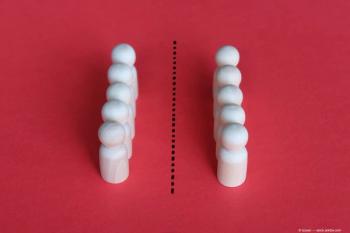
Multicomponent IOL offers solution for perfecting vision outcomes after cataract surgery
A multicomponent IOL system featuring an exchangeable front optic (PreciSight Lens, InfiniteVision Optics, Strasbourg, France) is showing promise for providing a reliable, reproducible, safe, simple, and time-independent solution for achieving desired refractive outcomes after cataract surgery, said Harvey S. Uy, MD.
Outcomes in a series of 30 eyes that underwent exchange of the front optic to correct dioptric power showed the procedure was safe and effective. Prior to enhancement, all patients had MRSE >1 D (mean 1.06 D) and < -1.0 D cylinder (mean -0.30 D). Mean logMAR distance uncorrected visual acuity (UDVA) prior to the enhancement was 0.19 (about 20/30 Snellen equivalent).
Analyses of data available from 30 eyes seen at 3 months post-enhancement showed statistically significant improvements in both mean MRSE (0.31 D) and mean logMAR UDVA of 0.02 (about 20/20 Snellen equivalent). There was no statistically significant change in mean cylinder. Furthermore, at 3 months, 100% of eyes had UDVA of 20/25 or better.
Additional measurements showed that the system exhibited excellent rotational stability; anterior chamber depth was unchanged after the exchange, indicating implant stability; and endothelial cell count was also unchanged. No other safety issues were observed, said Dr. Uy, clinical associate professor of ophthalmology, University of the Philippines, and medical director, Peregrine Eye and Laser Institute in Makati, Philippines.
“The fact that a significant number of patients are dissatisfied after multifocal IOL surgery is limiting uptake of these premium lenses by cataract surgeons. The reasons for dissatisfaction among these patients include significant residual refractive error and inability to adjust to the visual disturbances caused by multifocal optics,” Dr. Uy said.
“IOL exchange can address these concerns, but surgeons face a dilemma in deciding on the timing of the surgery. If the exchange is done too early, patients may be deprived of the chance to adapt to the primarily implanted lens, but if the exchange is delayed, the procedure becomes more difficult because of capsular fibrosis. This investigational multicomponent IOL system allows IOL exchange without any time limits. It gives surgeons a safety net to provide unhappy patients with a second chance. For that reason, it can build surgeon confidence in using presbyopia-correcting IOLs and their ability to build a premium IOL practice.”
The multicomponent IOL consists of two optics that are implanted simultaneously into the capsular bag at the time of cataract surgery.
The posterior base lens, which is larger than the anterior exchangeable lens, is made of hydrophobic acrylic, contains spherical power and remains fixed in the capsular bag. The exchangeable front portion is a hydrophilic acrylic lens and can feature any type of optic-multifocal, multifocal toric, aspheric, toric, telescopic-thereby allowing surgeons to address a full spectrum of refractive needs and goals through an enhancement procedure.
“A space is maintained between the two optics after they are implanted. As capsular fibrosis occurs and the base lens becomes more fixed, exchange of the front lens becomes even easier,” Dr. Uy said.
“If the problem is significant residual refractive error, then the front lens is exchanged for another that will correct the total power," Dr. Uy said. "If the front lens was a multifocal optic and the patient is intolerant of the visual symptoms or develops retina or nerve disease, the multifocal portion can be exchanged for a monofocal lens. Or, if a patient initially chose a monofocal lens and later became interested in presbyopia correction, the front optic can be exchanged for a multifocal optic.”
The system is easy to implant. The two refractive components are assembled outside the eye by affixing tabs on the front lens into bridges on the base lens. Then, the implant is injected into the eye through a 2.2- to 2.4-mm incision.
“Eventually, a preloaded injector will be available. Thus, the primary surgery is no more complex or time consuming than conventional cataract surgery,” Dr. Uy said.
He noted that the exchange procedure is also easy.
Ophthalmic viscoelastic is injected through a hole in the front optic, causing it to lift up and helping to detach it from the base. Without any need for cutting, the front optic is removed from the eye through the original clear corneal incision using commercially available IOL forceps.
The replacement optic is injected into the eye, and its tabs are guided into the bridges on the base using modified Sinskey hooks.
“The exchange generally takes less than 5 minutes to complete,” Dr. Uy said.
“The base lens protects the posterior capsule during the procedure and remains stable, without any change in axis, which establishes the feasibility of a toric IOL platform,” Dr. Uy said.
Disclosures:
Dr. Uy receives research funding from InfiniteVision Optics and from ClarVista Medical, which is developing another multicomponent IOL (Harmoni Modular IOL).
Newsletter
Don’t miss out—get Ophthalmology Times updates on the latest clinical advancements and expert interviews, straight to your inbox.








































